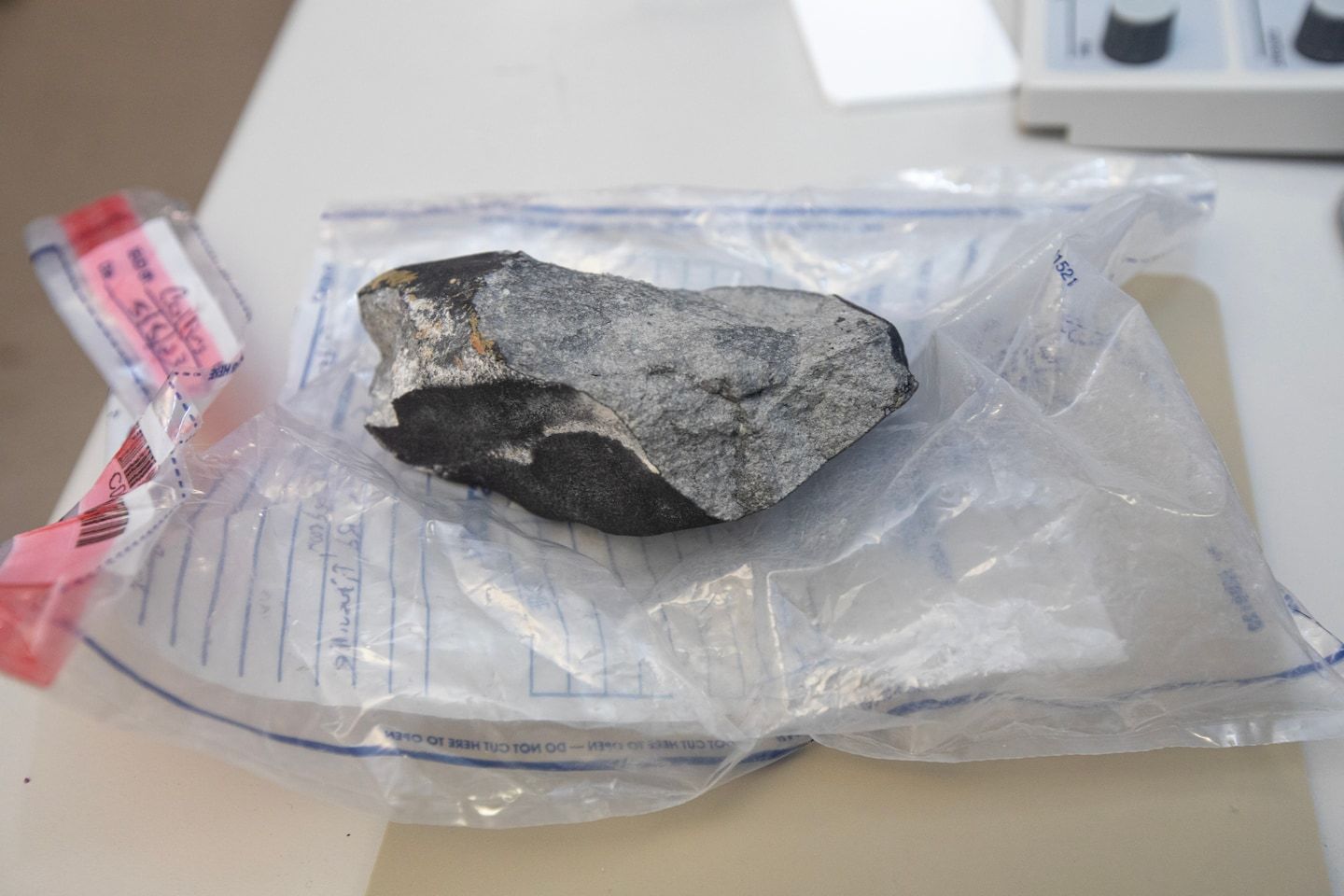Meteorite fragment punches hole through New Jersey family’s roof
Listen 5 min Comment on this story Comment Gift Article Share
At first glance, the avocado-size rock that Suzy Kop found in her father’s New Jersey home Monday could have been from any garden. But a closer look revealed jagged edges that exposed a gray-green interior underneath a charred, black crust. Wp Get the full experience. Choose your plan ArrowRight The rock was also warm to the touch and had fallen from the sky, striking the house with enough force to punch a hole through the roof and ricochet across the room.
Kop wondered whether there might be more to the pint-size wrecking ball that landed in her father’s bedroom. So she and her family asked physicists for answers. On Thursday, researchers at the College of New Jersey confirmed that the rock had tumbled from space.
The discovery of a meteorite sent a wave of excitement through Hopewell Township, where Kop’s father lives. Hobbyists have since flocked to the area to hunt for more meteorite fragments, and they aren’t the only ones star-struck. The meteorite offers a valuable opportunity for studying the reaches of space, experts said — one rarely discovered so dramatically.
Advertisement
“It’s nice to have a fun, interesting story that drops in out of the blue, literally,” Nathan Magee, head of the College of New Jersey’s physics department, told The Washington Post.
Christine Lloyd, Kop’s sister, confirmed that the family has the meteorite but said that the family did not wish to discuss further details.
Researchers determined that the meteorite that crashed through the family’s home is a type LL-6 chondrite, a rocky meteorite characterized by tiny mineral spheres within its body. This type is believed to be approximately 4.56 billion years old, around the age of the sun and the Earth, and originated from rocks in the asteroid belt between Mars and Jupiter, according to the College of New Jersey’s news release.
This meteorite’s journey ended hundreds of millions of miles away, in the drywall of a house in Hopewell, about 40 miles from Philadelphia. No one was harmed Monday when the rock punched a hole through the roof, according to WPVI. Kop found the small rock resting on the floor of an upstairs bedroom. The rock appeared to have blasted straight through the roof before ricocheting off the floor and back up to the ceiling, leaving dents across the room. It was warm to the touch, Kop told WPVI.
Advertisement
The family reported the incident to police, who contacted researchers at the College of New Jersey. The call reached geophysicist Shannon Graham, who was stunned to learn of such a rare discovery a 10-minute drive from the college’s physics department.
“If you would ask me, Monday morning, [the] top 100 reasons why I might get a phone call from the police, ‘meteorite’ would not have been on the list,” Graham said, laughing.
Graham said Kop and her family seemed just as curious as she was to learn about the suspected meteorite and its origins. The family visited the college on Wednesday to let Graham, Magee and a team of researchers examine the rock in a lab. Initial findings confirmed its cosmic origins, Magee said. The team measured the meteorite’s density. It weighs around two pounds and is much denser than most Earth rocks, he said. Researchers also examined its structure with an electron microscope. Under a powerful lens, researchers determined the meteorite’s composition and classified it as an LL-6 chondrite.
Advertisement
They also gave the meteorite a tentative name — “Titusville, NJ,” after a community within Hopewell Township — after a meteorite expert advised the team of the long-standing practice of naming meteorites after a geographical locality near where it is recovered.
The College of New Jersey’s findings confirmed how rare — and serendipitous — Kop’s discovery was. Only around 1,100 LL chondrites have ever been found, according to the college’s news release, and only 100 of those were observed falling. While the meteorite wasn’t detected by a satellite sensor in real time, Kop’s report allowed NASA to later review the meteorite’s final moments in flight through airport weather radar data, the agency announced.
Titusville, NJ is particularly valuable because of the wealth of data surrounding its landing, Magee said. Further examination of the meteorite’s composition, its flight path and the holes in the roof could provide an exceptionally clear picture of its trajectory through the solar system — and perhaps help identify the asteroid it originated from, he said.
Magee gleaned one more detail from his analysis: The cracked edges of the meteorite that exposed its gray interior suggests it broke apart from a larger meteorite after entering the atmosphere.
Advertisement
Officials in Hopewell Township have told residents to stay on the hunt for other fragments. In a social media post Tuesday, the township relayed a message from Mike Hankey, the operations manager for the American Meteor Society, encouraging residents to check their doorbell cameras and keep an eye out for other meteorites that may be scattered around the region. There’s plenty at stake, the announcement added: Even flooring or building materials damaged by a meteorite strike are valuable to collectors.
No other meteorite findings had been reported as of Thursday morning, a town spokesperson said. Hankey joined about a dozen meteorite hunters to search the area, but nothing turned up, he told The Post.
“It’s still early,” Hankey said. “I don’t want to discourage anyone from looking more.”
Kop’s family has been inundated with calls from collectors to purchase the rock, but they do not have plans to sell it, Magee and Graham said. Magee hopes to perform additional research on the meteorite with the family’s cooperation.
“They’ve been generous,” Magee said. “We’ll politely ask for more time with it.”
GiftOutline Gift Article
Source: The Washington Post


